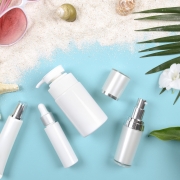Healthy Looking Skin is Happy Skin: How to Start a Skincare Routine

Skincare is often approached from an aesthetic standpoint. After all, most people want to feel good about the way they look. And healthy-looking skin is a great place to start.
But skin does so much more than simply dictate the way we look. Skin is the largest organ in—or on—your body. It protects you from bacteria, environmental factors, and the sun’s UV rays. It gets cut and scraped and stands up to the wear-and-tear of daily life. Needless to say, skin plays a pretty important role in your day-to-day health.
Here’s the good news: there are countless skincare products on the market. For those of us new to the skincare world, however, this can be a little intimidating. If you’re looking to start caring for your skin but don’t know where to start, look no further. This crash course in skincare will have you crafting a personalized skincare routine in no time.
The 4 Basic Skin Types
Before selecting products to improve your skin’s appearance, it’s important to know what you’re working with. Everyone’s skin is a little bit different, but it usually falls into one of four general categories: normal, oily, dry, or combination.
- Normal Skin Type: As the name suggests, the normal skin type is, well, pretty normal. It’s not too dry, not too oily, and doesn’t have many noticeable imperfections. Additionally, normal type skin doesn’t have any particular sensitivities.
- Oily Skin Type: If your skin is shiny or has a dull sheen to it, there’s a good chance you’ve got oily skin. Other hallmark features of the oily skin type are enlarged pores and blackheads. There’s also a good chance your face will feel slightly oily to the touch.
- Dry Skin Type: As opposed to oily skin, dry skin has small pores and almost no shine to it. It may feel rough to the touch, have more wrinkles and creases in it, or be slightly less elastic than other skin types.
- Combination Skin Type: As you read through the skin types above, did more than one seem like it described your skin? If so, you’ve probably got combination skin. This skin type refers to any combination of the skin types listed above. It’s very common to have an oily T-zone (the forehead, nose, and chin), for example, while the rest of your face is normal or even dry.
Once you’ve identified your skin type, it’s time to start thinking about your skincare goals. But more on that in the next section.
Identifying Your Skincare Goals
You wouldn’t take cough syrup to treat a broken foot—it’s not the right tool for the job. Similarly, your skincare products should align with both your skin’s needs and your personal skincare goals. Are you trying to clear reduce the appearance of wrinkles? Or simply keep your skin clean and hydrated? Whatever your end goal is, it will determine how you build your skincare routine.
Finding the right products can be tricky, but most skincare routines should follow the same four basic steps: clean, tone, moisturize, and protect (in that order). Within each of those four steps, there are countless products to choose from. As you select products for your skincare routine, pay attention to the active ingredients in each item you select. Different ingredients will have different effects—and you will want to choose ingredients that have the effect you want.
So what does this look like in practice? If you are creating a skincare routine for dry skin, you will want to choose a cleanser that’s gentle and can clean without removing all the oils on your skin. Similarly, you would want to stick to non-comedogenic products, which are specifically designed to avoid clogging pores. After all, using a pore-clogging skincare product would be a little counterintuitive, wouldn’t it?
How to Build a Skincare Routine: A Step-By-Step Guide
You’ve got the basics down, now let’s put it all together. How do you take all of this information—your skin type, your skincare goals, etc.—and create a personalized skincare routine? Just like anything else in life, take it one step at a time.
Step 1: Cleanse
Cleansing is the process of removing dirt, grime, and other impurities from your skin. Some cleansers are gentler than others, meaning they dry out the skin less and are less likely to cause skin irritation. If you have sensitive or dry skin, you will probably want to stick to a gentle cleanser, such as the Celvive Gentle Milk Cleanser.
A quick rule of thumb for cleansers: if you have dry and sensitive skin, use a cleanser that comes as a lotion or cream; if you have oily skin, use a foaming cleanser. As mentioned above, the active ingredients in cleansers vary from product to product, so be sure to review the active ingredients before purchasing cleanser.
Step 2: Tone
Toning is a loosely defined step in skincare routines. It is sometimes described as the process of “balancing” the skin—that is, giving your skin any nutrients it is missing. Some toners include active ingredients that act as additional cleansers, helping to remove debris and unclog pores. Because the cleansing process can be a bit abrasive for your skin, many toners include botanical ingredients that help soothe the skin.
Step 3: Moisturize
Just like staying hydrated is an important part of staying healthy, keeping your skin hydrated is an important aspect of skin care. And the best way to keep your skin hydrated is by including a good moisturizer in your daily skincare routine.
The most effective skin moisturizers tend to use plant-based oils to hydrate the skin. Different skin types do best with different types of moisturizers. If your skin is oily, you should use gel moisturizer. These tend to be mostly water-based, as opposed to oil-based. If you have dry or combination skin, opt for a moisturizer that comes as a lotion or cream.
Step 4: Protect
When it comes to skin damage, one culprit is usually responsible: the sun’s UV rays. Even on cloudy days, your skin is exposed to UV rays that can dry it out and damage it. Fortunately, there’s an easy solution: sunscreen or other SPF rated products.
Most experts recommend wearing a sunscreen of at least 30 SPF daily. This will help keep your skin protected throughout the day, reduce visible wrinkling, and help keep in moisture. (For your nightly skincare routine, you can skip the SPF.)
Consistency is Key
Like most health-related processes, skin care requires consistency. You can’t slap some cleanser and lotion on your face one night and expect to see immediate results—it takes time. As you build your skincare routine, be sure to implement it daily. If you aren’t seeing the results you want, give it a couple of weeks. (There is an exception: if a product irritates your skin, don’t hesitate to swap it for something else.)
Once you have practiced your skincare routine consistently for two to three weeks, evaluate the results. If you aren’t seeing progress towards your goals, it might be time to re-evaluate the products you are using. And remember, be gentle with yourself. If you miss a day, there is always tomorrow to start again!
References
https://www.webmd.com/beauty/whats-your-skin-type
https://www.sciencedirect.com/science/article/abs/pii/S0965206X16000280?via%3Dihub
https://www.nytimes.com/guides/tmagazine/skincare-routine
https://www.npr.org/2021/10/27/1049607370/build-a-basic-skincare-routine-in-three-steps
https://askthescientists.com/science-of-skincare/
https://www.mayoclinic.org/diseases-conditions/acne/in-depth/acne-treatments/art-20045814












